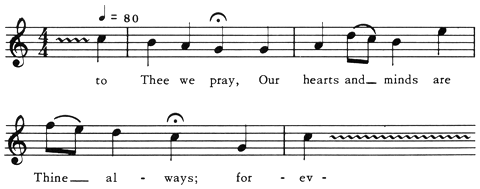| << Chapter < Page | Chapter >> Page > |
A fermata indicates a moment when the rhythmic motion of a composition ceases. There are basically two types of fermatas:
1. A fermata that contains two or more beats in the rhythm of the preceding passage.
2. A fermata of undetermined length.
There are instances when the fermata signifies the end of a previous tempo and the next note begins a new tempo. Fermatas are also often preceded by a slowing of the tempo into the fermata itself.
In moderate or slow tempos, or when a ritard is indicated, the conductor can show the coming of the fermata by a broadening of his conducting gestures. Except for sudden fermatas, this will be the guiding rule. In instances where the preceding note(s) is indicated with a ritard, the broadening will be coupled with a slowing of the tempo at that point, into the fermata.
If the tempo of the piece resumes, the cutoff of the fermata can often be used as the preparation of the next entrance. Figure 1 is an example where the end of the fermata can be the prepatoration for the next entrance. The conductor must be careful to have the hands in a high position at the end of the fermata that will allow him to continue with ease.

If the fermata is to be followed by a pause either indicated by a rest or by a stylistic implication in the score, the cutoff will be a complete gesture in itself. The conductor will then need to indicate the next entrance as he would any new entrance.
If the fermata is followed by a change of tempo, the preparation must be in the new tempo. One example of this type of fermata is seen in figure 2.

The question is often raised as to whether or not the conductor should continue to beat time during a fermata. In most instances a conductor should not conduct a part of a beat pattern during a fermata. Instead, the right hand might continue to move slowly, giving the ensemble an indication to keep the tone vibrant during the fermata. This is not the case with all fermatas, however. Some fermatas contain no internal rhythm (at least none that will warrant conducting motion). These fermatas can be held with the arms raised and extended. Avoid holding the arms with the palms up in these instances. One has no control over the ensemble with the hands in this position. The conductor will maintain a better conducting gesture if the palms face inward and the hands remain slightly cupped (if a baton is not being used).
Works that contain examples of fermatas:
1. Break Forth, O Beauteous Heavenly Light, Bach, Lawson-Gould
2. Psalm 150, Schutz, Robert King Music Co. # 601
3. A Boy Was Born, Britten, Oxford University Press, # 84.092
4. Twenty-one Chorales, Bach, Schmitt, Hall, and McCreary
5. Why Are the Roses So Pale?, Carr, G. Schirmer, Inc.

Notification Switch
Would you like to follow the 'Choral techniques' conversation and receive update notifications?